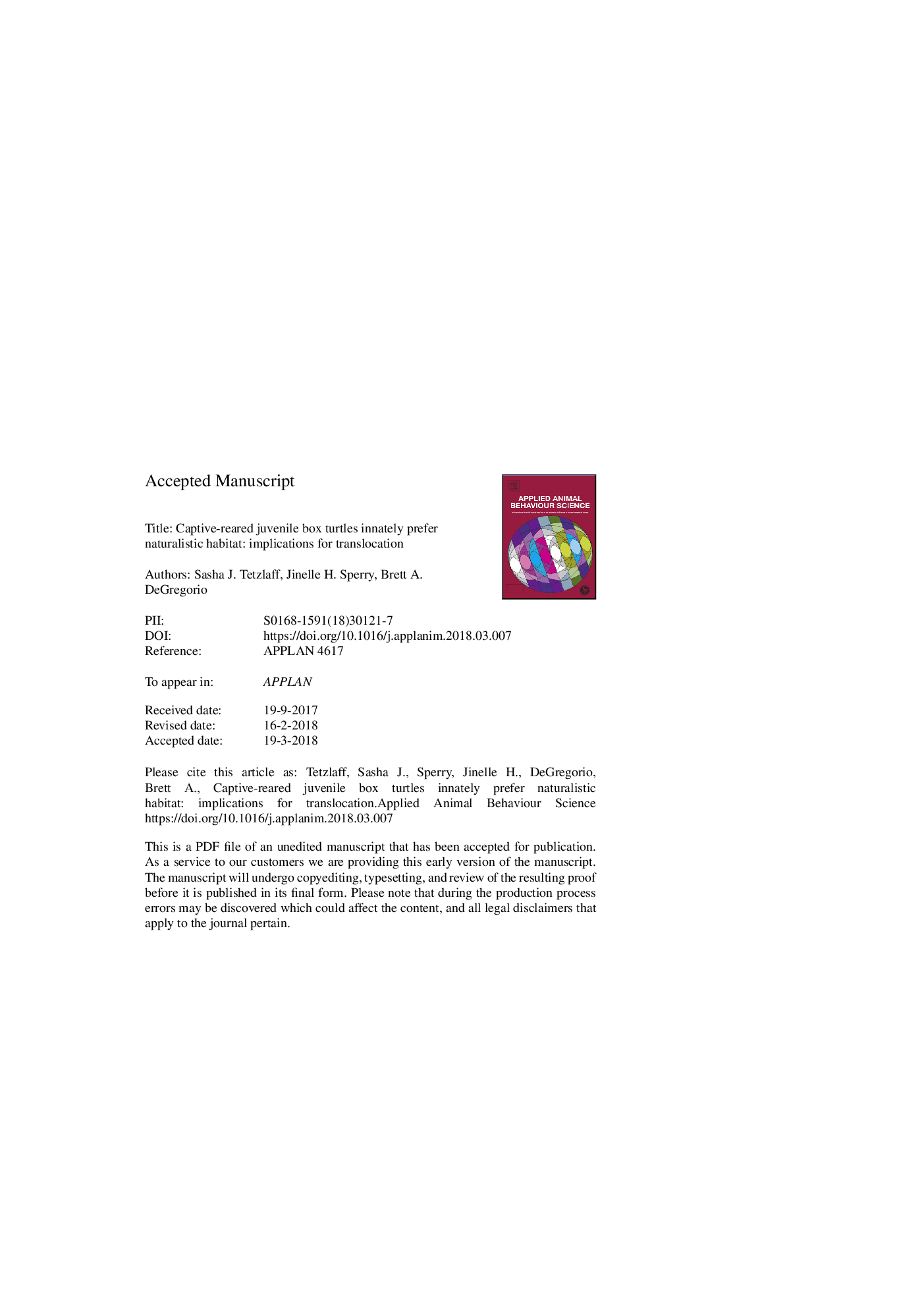| کد مقاله | کد نشریه | سال انتشار | مقاله انگلیسی | نسخه تمام متن |
|---|---|---|---|---|
| 8882763 | 1625302 | 2018 | 24 صفحه PDF | دانلود رایگان |
عنوان انگلیسی مقاله ISI
Captive-reared juvenile box turtles innately prefer naturalistic habitat: Implications for translocation
ترجمه فارسی عنوان
لاک پشت های جعبۀ نوجوانان زندانی محکم تر از محیط زیست طبیعت گرایان را ترجیح می دهند: پیام هایی برای
دانلود مقاله + سفارش ترجمه
دانلود مقاله ISI انگلیسی
رایگان برای ایرانیان
کلمات کلیدی
موضوعات مرتبط
علوم زیستی و بیوفناوری
علوم کشاورزی و بیولوژیک
علوم دامی و جانورشناسی
چکیده انگلیسی
Habitat choice has broad repercussions for animals, but mechanisms influencing such choices are generally not understood. When conducting conservation translocations using captive-reared animals, elucidating mechanisms influencing habitat preference pre-release could inform rearing methods and post-release behavior. We raised 32 captive-born eastern box turtles (Terrapene carolina) for eight months-16 in naturalistic enriched enclosures and 16 in unenriched enclosures. We then let each turtle choose between environments simulating both rearing conditions in a novel enclosure to evaluate the hypothesis that rearing environment influences habitat selection. Preference for the enriched environment was exhibited by enriched (selection probabilityâ¯=â¯0.81, 95% CI: 0.54-0.96) and unenriched (selection probabilityâ¯=â¯0.88, 95% CI: 0.62-0.98) turtles. Those that chose the enriched habitat (nâ¯=â¯27) did so in less than half the time (x¯â¯=â¯504.8â¯s, 95% CI: 266.49-743.04) than those that selected the unenriched one (nâ¯=â¯5, x¯â¯=â¯1339.0â¯s, 95% CI: 783.84-1894.07, Pâ¯=â¯0.009). Selection latency did not differ between rearing treatments (Pâ¯=â¯0.871). We conducted a second experiment to clarify if preferences were based on familiarity or novelty by using the same enclosure, but we gave individuals a choice between the habitat representing their rearing condition and a novel object (empty tissue box). Preference for respective rearing environment was exhibited by enriched (selection probabilityâ¯=â¯0.87, 95% CI: 0.59-0.98) and unenriched (selection probabilityâ¯=â¯0.81, 95% CI: 0.54-0.96) individuals. Selection latency did not differ based on side chosen (Pâ¯=â¯0.439) or rearing treatment (Pâ¯=â¯0.764). Selection latency was repeatable by individuals (Râ¯=â¯0.47, 90% CIâ¯=â¯0.24-0.71, Pâ¯=â¯0.003), and this personality trait may be heritable since it was also repeatable by clutch mates (Râ¯=â¯0.36, 90% CIâ¯=â¯0.03-0.62, Pâ¯=â¯0.001). Preference for a naturalistic environment by captive-born eastern box turtles appears to be driven by an innate mechanism rather than based on prior experience. Housing this species in enriched enclosures should increase welfare. Moreover, our collective findings highlight the importance of evaluating how intrinsic effects could affect translocation outcomes.
ناشر
Database: Elsevier - ScienceDirect (ساینس دایرکت)
Journal: Applied Animal Behaviour Science - Volume 204, July 2018, Pages 128-133
Journal: Applied Animal Behaviour Science - Volume 204, July 2018, Pages 128-133
نویسندگان
Sasha J. Tetzlaff, Jinelle H. Sperry, Brett A. DeGregorio,
